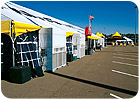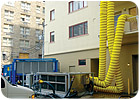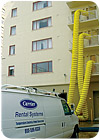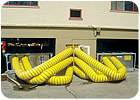
Nine portable air conditioners traveled the country providing comfort conditioning in two tents (totaling 17,000 sq ft) for General Motors' AutoShow in Motion - a 30-city tour that ran from January through November 2005 and featured more than 150 of the company's vehicles. (Photo courtesy of GM Auto Show In Motion and Kohler Rental Power.)
Hot wheels, cool customers
Keeping guests comfortable when they're attending an event can be a relatively simple proposition as long as the right equipment is in place. However, when you're talking about a mobile event that takes place each Thursday through Sunday and then moves to its next location, things can get a bit dicier.Kohler Rental Power had been contracted by Event Solutions, Inc. (ESI), a Michigan company hired by General Motors/GMR*Works as the special events coordinator for GM's third annual AutoShow in Motion (ASIM) - a 30-city tour that ran from January through November 2005. Featuring more than 150 of the company's vehicles, these free events allowed visitors to test-drive a huge variety of vehicles ranging from Hummers to Corvettes on controlled courses, and they even included complimentary refreshments and child play areas.
road rules?
The road trip took ASIM from a high temperature of 100°F in Houston to 45° in Pomona, CA. Kohler handled necessary equipment such as climate-controlled tents and luxury restrooms for ESI with visitors totaling more than 200,000 during the 11-month period. One of the ASIM tents was used for show registration, requiring four units to maintain a 7,000-sq-ft area. The second tent contained food and beverages for show participants, requiring five units to condition 10,000 sq ft."Touring with a show requires a different skill set than other event work," said Don Gray, senior account executive for Kohler. "For most large events, you set up power, restrooms, A/C, and you're there a week or ... maybe 90 days. Then you go home.
"But when you add the traveling component of a national tour, you're forced to think outside the box. Plus, every show is different. It takes a special team to live on the road and be ready for game day every weekend." The event was set up on Mondays, with the actual festivities taking place Thursdays through Sundays.
Kohler, a manufacturer of generator equipment for approximately 85 years, entered the special events market in the late 1990s to better showcase its equipment. At that time, the company created a special division in an effort to meet customer requests for individualized care. Nine portable air conditioners from United CoolAir Corp. were selected to provide comfort conditioning in two tents for the GM show.
Two separate teams of rental technicians (including Gray) traveled with ASIM to handle setup, packing and unpacking, and maintenance. "Setup was time sensitive. Many times, the local dealers would require us to be ready in advance before they could have a dealer event," Gray recalled. Dismantling of the event and loading the trucks to move on to the next city had to be completed on the last day of the event (Sunday), which often led to late nights and darkness.
United CoolAir's 20-ton, air cooled, vertical-style portable air conditioners were ideal for the job since its slim, rugged design allowed easy installation and reliable operation at every site. Each unit was customized to include both cooling and heating capabilities, since it was unknown what sort of weather would be encountered along the way.
Gray said that United CoolAir made it easy to manage equipment on the road with effective, functional features, and accessible components. "We were focusing on the installation and tear-down phases at every stop, especially since you didn't know how much equipment might get jarred during transportation and handling," Gray said. The units were transported on a 53-ft flat bed trailer and packaged for each tent.
He added that another benefit was the ability to easily maneuver units on the jobsite because of a four-way pod in each base for forklift accessibility. "And GM really liked the fact that the units presented a clean, uniform appearance." In addition, the fact that all nine units used the same voltage made for less complications working with other equipment at the show.

This chiller, air handler, and temporary flex duct were used to introduce air into portion of this 14-story building while its entire electrical service was repaired after damage resulting from Hurricane Katrina.
PREVENTIVE HVAC PITSTOPS
Just as the vehicles being promoted on the tour had to receive routine maintenance, so did the HVAC units that kept the show's visitors comfortable. On site and after hours, the units' HVAC filters were regularly cleaned using a pressure washer and key components and bolts were frequently checked to ensure they hadn't loosened from excessive vibration during operation or transportation. Also, as the generators went from city to city, they occasionally pulled into Kohler facilities for routine maintenance.The ASIM was a success, and the grind of the road didn't take too much of a toll on any of the involved participants - or equipment.
"The selected equipment was a result of collaborative efforts with Kohler for this specific project," said Rod Beever, vice president of sales and marketing at United CoolAir. "Refrigerant components in particular were designed in such a way that the units could handle any climate condition faced during the tour."

Introducing cool dry air to the building via doors allowed the maintenance of appropriate humidity levels. The key to the success of the project was maintaining a balance of air escaping out of the building and replacing it with enough conditioned air to maintain the space.
Managing moisture after the hurricane
And while temporary HVAC panned out just fine for the ASIM, another impermanent HVAC application was called upon to help an apartment-turned-hotel-turned-resort recover from Hurricane Katrina damage in New Orleans.This 14-story structure was entirely evacuated prior to Hurricane Katrina striking the Louisiana coast. The building, which was constructed in the city's Garden District in the 1950s, was designed as an apartment complex. It had been converted into a 264-room condo in the 1980s, and about five years ago, its current owners renovated it to operate as a timeshare resort/hotel and restaurant.
Compared to the rest of the city, the building made it through the disaster in fairly decent shape. However, when floodwaters spilled into its basement, everything on that level was destroyed - including the main electrical service - and the building sustained some minor roof damage and a few broken windows.
New service necessary
"With everything else in the basement, the contaminated floodwaters destroyed the building's main electrical service including switch gear, panels, wiring, breakers, and more," said Norris Ortolano, the buildings' chief engineer. A secondary electrical service had been added a few years earlier to feed the elevators and restaurant. "Fortunately, our secondary service was able to get back up and running a short time after the storm. So we were able to get the restaurant, elevators, and secondary lighting back in service," said Ortolano."After the storm and initial evaluation of the facility, we knew we had to address our electrical service issue. Not only were we going to have to replace and relocate the entire electrical service, but now we would have to address a new concern with the building being left in an unconditioned state for an extended amount of time," continued Ortolano. By removing the electrical service, each room's individual water source heat pump would be down during the entire project. To further complicate matters, the total destruction throughout the city stretched thin the number of available contractors and increased the amount of time to complete any project.
The building's owners had to address the HVAC need quickly. Several possible solutions were considered, including bringing in large dehumidification equipment. The cost and additional heat load made that solution impractical. "About six years ago, I had an experience with temporary air conditioners and decided to call Carrier Rental Systems to design an economical solution. Our main priority [for this project] was to maintain humidity levels to protect the furnishings, drapes, carpets, cabinetry, and the rest of the facility from mold, mildew, and other potential contaminants," said Ortolano.

While this temporary duct has an octopus-like appearance, the two AHUs are actually introducing air into the stairwell of the hotel as part of a strategy that also incorporated a temporary chiller, fuel tank, and generator in limited space. The stairwells' access points were used as giant plenums.
Weighing the options
Bruce Godbery and Toby Sarradet from Carrier Rental Systems' Baton Rouge office went to the site and evaluated the project. "There were several challenges to overcome," recalled Godbery. "The first option would be temporary generators. Unfortunately, the flood damage eliminated existing tie-ins and would greatly limit the electrical contractor while working around ‘live' wires and panels." Another major hurdle was that the fuel costs for running large generators over an extended time would have been astronomical. In addition to the limited space of a downtown area, neighbors were concerned about noise and emission pollution. Large temporary generators were eliminated as an option.The second option would be to provide a temporary A/C system to maintain the humidity levels on all 14 floors during the renovation. "This option also faced many challenges," said Sarradet. "We still had to deal with the limited space for temporary equipment and the only available spot on the property was a small parking area with limited access," continued Sarradet.
Like any other metro area, finding enough space on city streets would be difficult. Traffic and pedestrians still needed to move freely. Another challenge was that the building's footprint did not leave a lot of options. "The building is shaped like an ‘H', creating difficult areas to reach," said Sarradet. Finally, without utility power available, whatever the finished design, temporary power would still be needed. Carrier Rental Systems would have to create a solution utilizing minimum power.
The Solution
The company decided to employ air cooled chillers providing 320 tons of high-static, 100% outside air, and AHUs producing over 65,000 cfm. The AHUs would introduce cool dry air into the building and maintain appropriate humidity levels. The key to the success of the project was maintaining a balance of air escaping out of the building and replacing it with enough conditioned air to maintain the space."After spending time with Norris [Ortolano] and getting familiar with the facility, we decided to take advantage of the building's stairways and access points and use them as large plenums," said Sarradet. By creating positive pressure within the space, the cool, dehumidified air would be forced throughout hallways and rooms maintaining comfortable and safe humidity levels. By creating a temporary chilled water system design, Carrier Rental Systems was able to run the system only utilizing one 800kW generator - significant savings compared to the amount of power and distribution required for multiple A/Cs capable of conditioning all 14 floors.
"The temporary system is doing exactly what we expected and we are satisfied that this final solution will protect both the structure and contents during our renovation," said Ortolano.
